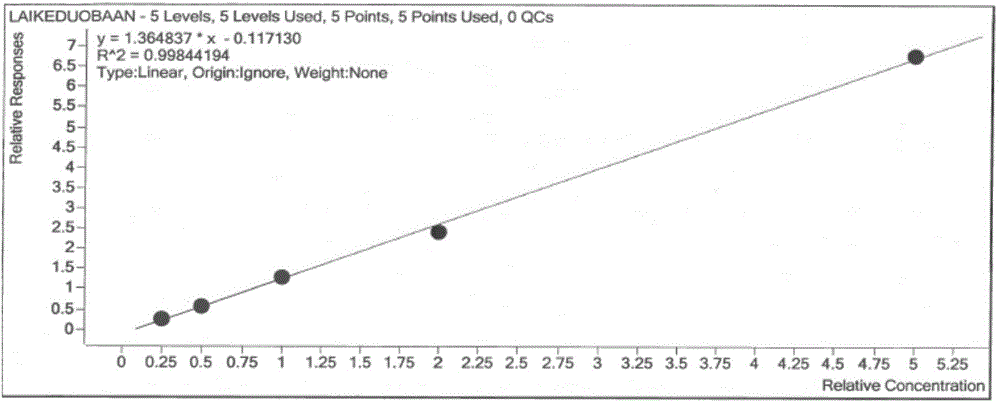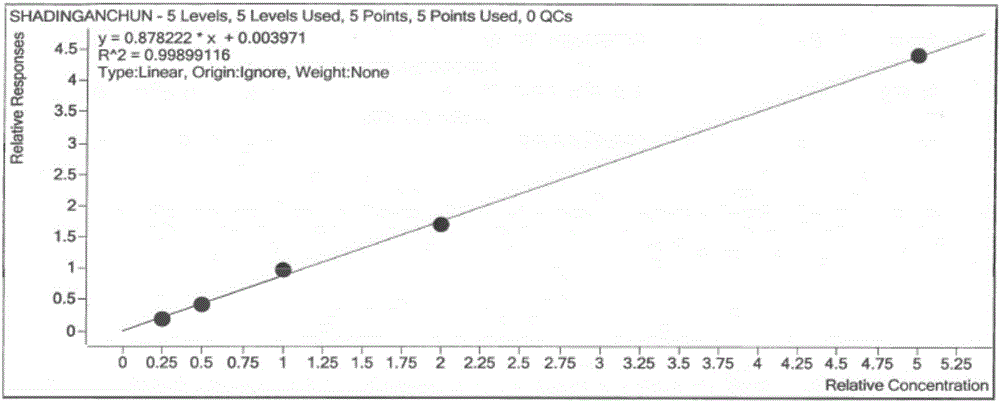Method for detecting beta-receptor agonist residual quantity in animal derived food
A receptor agonist, animal-derived technology, applied in the field of analytical chemistry, can solve the problems of lack of detection efficiency and cost, long processing time and high cost, and achieve improved detection time and cost, shortened detection time, and high accuracy. Effect
- Summary
- Abstract
- Description
- Claims
- Application Information
AI Technical Summary
Problems solved by technology
Method used
Image
Examples
Embodiment 1
[0061] Embodiment 1: detection method of the present invention
[0062] Take the β-receptor agonist mixed standard working solution with a concentration of 1 μg / mL, dilute it into a 100 ng / mL mixed standard working solution, take 0 μL, 12.5 μL, 25 μL, 50 μL, 100 μL, and 250 μL respectively with 2% formic acid / water- The methanol solution was dissolved and the volume was adjusted to 0.5 mL. Then liquid chromatography tandem mass spectrometry detects, obtains standard curve;
[0063] Accurately weigh 5.00g of the sample to be tested in a 50ml centrifuge tube, add 100uL of 100ng / mL isotope internal standard working solution, then add 20.0mL of 0.1mol / L hydrochloric acid solution, add to a boiling water bath and boil for 30min, ultrasonically extract for 10min, use Adjust the pH to 9.5±0.1 with 10mol / L NaOH solution, centrifuge to take the supernatant, add 10mL of ethyl acetate to extract, vortex for 2min, centrifuge to take the organic phase and put it in another centrifuge tube...
Embodiment 2
[0067] Example 2: Linearity and working curve range
[0068] Prepare clenbuterol hydrochloride, ractopamine, and albuterol 2.5ng / mL, 5ng / mL, 10ng / mL, 20ng / mL, 50ng / mL gradient concentration standard working solutions for detection, and prepare working curves. The results are shown in Figure 1-3 , Table 4-5.
[0069] Table 4 The peak area of clenbuterol hydrochloride, ractopamine and salbutamol concentration
[0070]
[0071] Table 5 Linear relationship between clenbuterol hydrochloride, ractopamine and albuterol
[0072] Substance name slope intercept Linear Fit Correlation Coefficient Clenbuterol Hydrochloride 1.523593 0.042159 0.9991 Ractopamine 1.364837 0.11713 0.9984 salbutamol 0.878222 0.003971 0.9989
[0073] From the above results, it can be known that the linear fitting correlation coefficients are all higher than 0.990, the curve meets the requirements, and the applicable concentration range is 0.25-5 μg / kg.
Embodiment 3
[0074] Embodiment 3: detection limit and quantitative limit
[0075] Prepare clenbuterol hydrochloride, ractopamine and salbutamol 2.5ng / mL respectively, repeat the measurement at least 6 times, collect the signal-to-noise ratio, statistical detection limit and quantification limit for each time, and the results are shown in Table 6.
[0076] Table 6 Limits of detection and limits of quantitation
[0077]
[0078] As can be seen from the above table, the detection limit of the present invention is far lower than the reported detection limit, which not only meets the requirements, but also has higher sensitivity.
PUM
| Property | Measurement | Unit |
|---|---|---|
| concentration | aaaaa | aaaaa |
Abstract
Description
Claims
Application Information
 Login to View More
Login to View More - R&D
- Intellectual Property
- Life Sciences
- Materials
- Tech Scout
- Unparalleled Data Quality
- Higher Quality Content
- 60% Fewer Hallucinations
Browse by: Latest US Patents, China's latest patents, Technical Efficacy Thesaurus, Application Domain, Technology Topic, Popular Technical Reports.
© 2025 PatSnap. All rights reserved.Legal|Privacy policy|Modern Slavery Act Transparency Statement|Sitemap|About US| Contact US: help@patsnap.com



